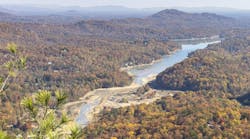
We’re continuing our countdown to Infrastructure Week with another interview—a very comprehensive look at the issues, with a lot of food for thought. A couple of quick spoilers: This week’s interviewee does see an advantage to public-private partnerships for some projects (not all of our experts agree), and he favors fees to pay for infrastructure rather than general tax funds (which, as he points out, “have to compete with libraries, fire stations, the arts, and a host of other services perceived by the public as higher priority”).
Our Q&A this week is with Gordon England, a civil engineer in Florida and a long-time member of Stormwater’s editorial advisory board. Gordon has worked as a stormwater consultant in various positions—including a stint several years ago with the Bahamian Ministry of Works—and has a wide-ranging perspective on the issues of infrastructure.
We posed the same questions to Gordon as to our other industry experts in all the areas Forester Media’s publications cover. You can see some of the other responses here, here, here, and here. We invite you to share your perspectives in the comments section below or join our Twitter Chat (#InfrastructureMatters) on May 18 from 11 a.m. to 12 p.m. PDT.
Gordon England (GE): Thank you for inviting me to your discussion of these important topics. To start with, I would like to point out that this discussion is about critical aspects of our modern technical society, but the resolution to resolving infrastructure maintenance and upgrades is not so much a technical issue as a political issue.
Stormwater (SW): Which infrastructure projects should be given priority? Roads and bridges? Dams and levees? Water supply? Electrical grid?
GE: Based on safety being the highest priority, bridge failures represent the most immediate and shocking of infrastructure failure incidents.
Dam and levee failure is second. The immediate loss of life is not as significant as bridge failure, but homes roads, bridges, and whole towns are often destroyed when dams break, delivering short- and long-term impacts to many citizens.
Third is our electrical grid, an invisible but crucial lifeline for our lifestyles and the whole of the nation’s economy. Virtually every element of modern daily life is tied to electrical devices.
Next is water supply, a quality-of-life issue. The days of plentiful, inexpensive potable water are over. Potable and irrigation water shortages will force reconsideration of lifestyles and drive conservation, wiser and more expensive reuse from stormwater and wastewater, smarter agricultural water practices and use, and more desalination plants where feasible.
Last, but not least, are our roadways, utilized for transportation of numerous goods and supplies, as well as allowing urban areas to spread away from core downtown areas, following generational migration patterns from rural to urban areas and back out to suburbs.
SW: Is there a solution to long-term infrastructure funding?
GE: Long-term funding for infrastructure is a difficult issue because these amenities are built with long useful lives, making them easy to fall off of short-term radar screens of tax revolts, term limits, a boomer generation trying to survive their later years, and a new generation of people who take our modern services for granted. These now become discussions of social issues.
Our current funding methods are not adequate to address infrastructure needs. The solution is finding a way to negotiate change in our political and regulatory structures to obtain more funds for these projects. The longer we wait to address these issues the more expensive they will be to fix. Do we keep kicking the can down the road to the next generation?
There is no single solution to long-term funding within the confines of our present funding mechanisms and tax structures. For a start, we must be more creative and wiser with utilization of funding sources as our needs of these critical systems evolve and mature. Tax rates and replacement budgets for infrastructure were developed many years ago. Our modern society demands new technology and associated costs that advance at exponential rates far beyond what was foreseen and budgeted in the past. If we want to continue to develop as a modern society, we must realize that governments must spend more funds for infrastructure to keep up with increasingly technical needs.
Each type of infrastructure is unique and requires different approaches in different regions of the country.
Local governments are closer to public scrutiny and cannot easily increase taxes. Strong salesmanship is needed by authorities through open discussions with constituents to discuss their concerns and priorities to obtain a consensus for funding projects, as well as to detect levels of pain associated with new fees. The critical roles that infrastructure plays in each person’s life needs to brought to their radar screens. The public rarely supports new taxes that go into the general budget black hole of a government. It’s easier to sell project-specific or service-specific fees rather than to raise property taxes. Citizens more readily pay water, stormwater, sewer, electric, or turnpike fees when they know exactly what they are receiving. Bonds are also often utilized for specific purposes of roads, park construction, endangered land acquisition, and other needs that concern local users.
The challenge for road and bridge maintenance at a local level that is these items are almost always funded from general tax funds and have to compete with libraries, fire stations, the arts, and a host of other services perceived by the public as higher priority. Roads are invisible until there are potholes. All infrastructure will fare better if it is funded by fees rather than general funds that take a beating during tax revolts and election years.
In total, one in nine of the nation’s bridges are rated as structurally deficient, while the average age of the nation’s 607,380 bridges is currently 42 years. The Federal Highway Administration estimates that to eliminate the nation’s bridge deficient backlog by 2028, we would need to invest $20.5 billion annually, while only $12.8 billion is being spent currently. The challenge for federal, state, and local governments is to increase bridge infrastructure investments by $8 billion annually to address the identified $76 billion in needs for deficient bridges across the United States. New road and bridge infrastructure at a local level (not maintenance) is generally funded by gas taxes. The federal excise tax is 18.4 cents per gallon of gasoline and 24.4 cents per gallon of diesel. State and local fuel taxes add an average of 29–30 cents per gallon of gasoline, and 54 cents per gallon for diesel. For the foreseeable future, the recent drop in fuel prices will remain relatively low as the US continues to reduce its dependence on imported oil. Increased fuel efficiency of automobiles leads to lower fuel usage, which unfortunately leads to fewer fuel taxes collected for an increasing number of vehicles on roads and bridges not designed for current, much less future, traffic loads. Now would be a good time to increase fuel taxes and fuel tax caps. The net effect on the wallet would not be so intrusive.
Regulators should always take advantage of a crises or failure to increase budgets for dam and levee improvements. Strike for new fees while the issue is on the radar screen.
SW: What kind of harm is the current state of our infrastructure doing to the economy and the community?
GE: When roads and bridges are overloaded, costs increase for delays in transportation, which are reflected in every item bought in stores. When there are failures such as Katrina or I-95 shutting down in South Carolina, costs to society are massive for reconstruction. Dwindling water supplies in the West smother growth and quality of life. Electrical blackouts in major population centers create immediate, large-scale health, safety, and welfare issues.
SW: What can various government entities—from local to federal—do to attract private sector support and investment?
GE: Semiprivate utilities such as energy companies have more latitude with increasing fees for modernization, as we have seen with fiber-optic cables being installed over much of the urban areas in a short period of time to evolve a hobby Internet system into a critical need. Some communities have already turned to public-private partnerships for development of water supplies. Such partnerships could be considered for dams and levees to enable more effective long-term maintenance of infrastructure, as long as their funding authority is adequate to cover long-term maintenance.
SW: Thank you Gordon!
About the Author
Janice Kaspersen
Janice Kaspersen is the former editor of Erosion Control and Stormwater magazines.

